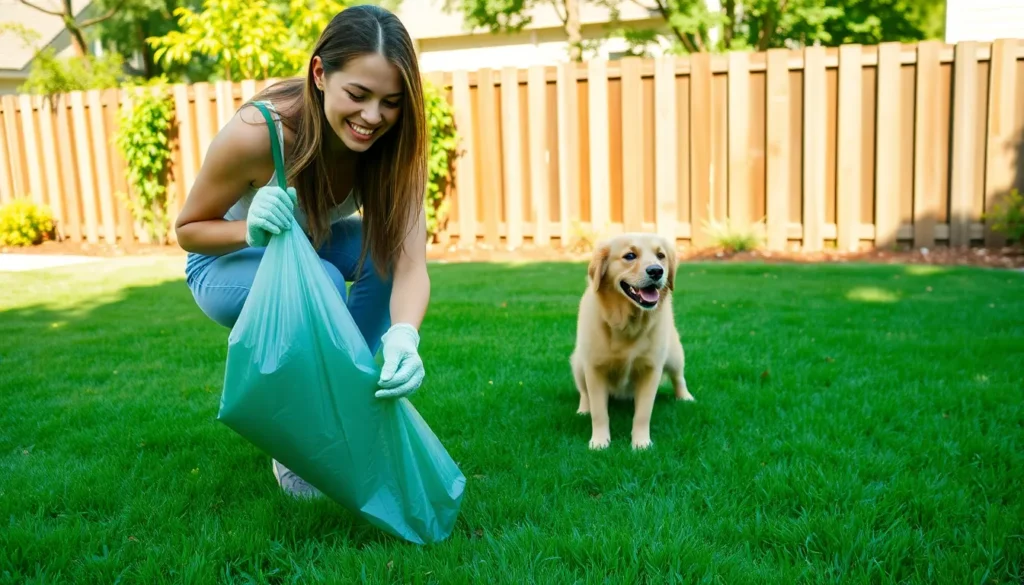Imagine a world where your furry friend listens to your every command—sounds like a dream, right? Enter the pet training clicker, the magical little gadget that transforms chaos into harmony. With just a click, you can turn your pup’s “oops” moments into “yes, I did that!” achievements. It’s like having a tiny coach in your pocket, ready to reward your pet’s best behaviors with a satisfying sound.
Table of Contents
ToggleOverview of Pet Training Clicker
A pet training clicker serves as a valuable tool in animal training practices. This small device produces a distinct sound to signal desired behaviors, allowing owners to reward pets effectively. Trainers can shape behaviors by pairing the click sound with positive reinforcement, such as treats or praise.
Many pet owners prefer clickers for their simplicity and effectiveness. They provide a clear communication method, helping pets understand actions that lead to rewards. Consistency is key; using the clicker every time a pet exhibits the desired behavior reinforces learning.
Clickers work well with various animals, including dogs, cats, and even birds. Visual cues can enhance learning alongside the auditory signal, creating a well-rounded approach. Choosing a sturdy clicker ensures durability during training sessions.
Training sessions can be short and engaging. Typically lasting 5 to 10 minutes, these sessions help maintain a pet’s focus and enthusiasm. Frequent mini-sessions facilitate retention of learned behaviors, making it easier for pets to grasp new commands over time.
Proper timing matters with clicker training. Instantaneously clicking when a pet performs the desired action solidifies the connection between behavior and reward. This leads to faster learning and stronger associations.
Many resources exist for training techniques involving clickers. Books, videos, and online courses offer guidance on effective methods. By utilizing these resources, owners can master clicker training for their pets, enhancing the bond between them while ensuring enjoyable learning experiences.
Benefits of Using a Clicker

Using a pet training clicker provides numerous advantages in training pets effectively. This tool enhances the training experience, allowing for clear communication and rewarding positive behavior.
Positive Reinforcement
Positive reinforcement becomes more effective with a clicker. The click sound marks the exact moment a pet performs a desired action, creating a strong association with rewards. Treats or praise given immediately after clicking encourage pets to repeat the behavior. Research indicates that this method increases learning speed and retention. For example, dogs respond better when they hear a click right after sitting. Cats also benefit from this technique, often learning tricks more quickly. Implementing a clicker facilitates an enjoyable training environment, strengthening the bond between pets and their owners.
Improved Communication
Improved communication is another key benefit of using a clicker. The distinct sound provides clarity for pets, making it easier for them to understand what they did right. Consistent use of the clicker reduces confusion and frustration during training sessions. For instance, pets learn commands like “stay” or “come” more reliably when they’re clicked for correct responses. Moreover, owners find it easier to convey their expectations. When both parties understand the training cues, sessions become more productive. The combination of auditory and visual signals allows for a well-rounded training approach, enhancing overall pet behavior.
How to Use a Pet Training Clicker
Using a pet training clicker involves simple steps that enhance communication during training. Training should begin with the pet learning that a click means a reward is near.
Step-by-Step Guide
- Position the clicker within easy reach for quick access.
- Start with a quiet environment to minimize distractions.
- Show the desired behavior and click immediately when it occurs.
- Follow the click with a treat or praise to reinforce the behavior.
- Repeat the process consistently so the pet associates the click with positive outcomes.
Tips for Effective Training
- Keep training sessions short, around 5 to 10 minutes, to maintain engagement.
- Vary treats to keep the pet motivated and excited.
- Use the clicker for one behavior at a time, avoiding confusion.
- Gradually increase the difficulty level of commands as the pet learns.
- Incorporate fun and patience, creating a positive atmosphere during training.
Different Types of Clickers
Clickers come in various types, each designed to meet different training needs. Understanding these types can enhance the training experience for pets and their owners.
Standard Clickers
Standard clickers represent the most commonly used type in pet training. These devices feature a simple button that produces a distinct clicking sound. Many owners appreciate their affordability and effectiveness. The sound helps pets associate good behavior with immediate rewards. All pets, including dogs and cats, can benefit from this straightforward approach. Owners find this design easy to use, making it a popular choice for training sessions. These clickers often come in bright colors, making them easy to locate during practice.
Remote Clickers
Remote clickers provide a more versatile training option. Such devices allow owners to train pets from a distance, offering increased flexibility during sessions. Trainers frequently use remote clickers for behaviors that require more space, like agility training. These clickers often include a wrist strap for easy access. Convenience becomes key, as it enables multi-tasking when handling other training equipment. Many models also feature adjustable sound volume, accommodating pets easily distracted by loud noises. Ensuring the clicker’s sound level is appropriate allows for more effective communication during training.
Common Mistakes to Avoid
Choosing a pet training clicker requires understanding common errors that can hinder progress. Many owners click the device at the wrong moment, which confuses pets. Timing matters significantly; clicking too late or too early disrupts the association between behavior and reward.
Failing to reinforce immediately after a click also creates inconsistency. After clicking, prompt rewards like treats or praise engage pets effectively. Sticking to only one type of reward can reduce motivation. Varying treats maintains interest during training sessions, making the experience enjoyable.
Overestimating a pet’s attention span often leads to frustration. Keeping training sessions short—between 5 to 10 minutes—ensures pets remain focused. Neglecting to create a fun atmosphere can also hinder training success. A relaxed environment encourages engagement, positivity, and enthusiasm.
Repetition is crucial; however, repeating the same command too many times makes it ineffective. Progressing too quickly to advanced commands can overwhelm pets. Gradually increasing difficulty helps solidify learned behaviors before adding new ones.
Ignoring distractions can be another oversight. Training in a quiet, controlled space prevents outside stimuli from interrupting sessions. Many owners also forget to consistently use the clicker. Consistency builds strong habits, enhancing learning and behavior retention.
Lastly, some trainers bypass visual cues. Incorporating hand signals alongside the clicker provides clarity and strengthens communication. Recognizing these common mistakes enhances the efficiency of clicker training, reinforcing positive experiences for both pets and their owners.
Using a pet training clicker can significantly enhance the training experience for both pets and their owners. This simple yet effective tool fosters clear communication and reinforces positive behaviors through immediate feedback. By maintaining consistency and focusing on a fun atmosphere, training sessions can become enjoyable and productive.
As pet owners explore the various types of clickers available, they’ll find options that suit their training needs. With the right techniques and an understanding of common pitfalls, clicker training can lead to faster learning and a stronger bond between pets and their humans. Embracing this method can transform training into a rewarding journey for everyone involved.








